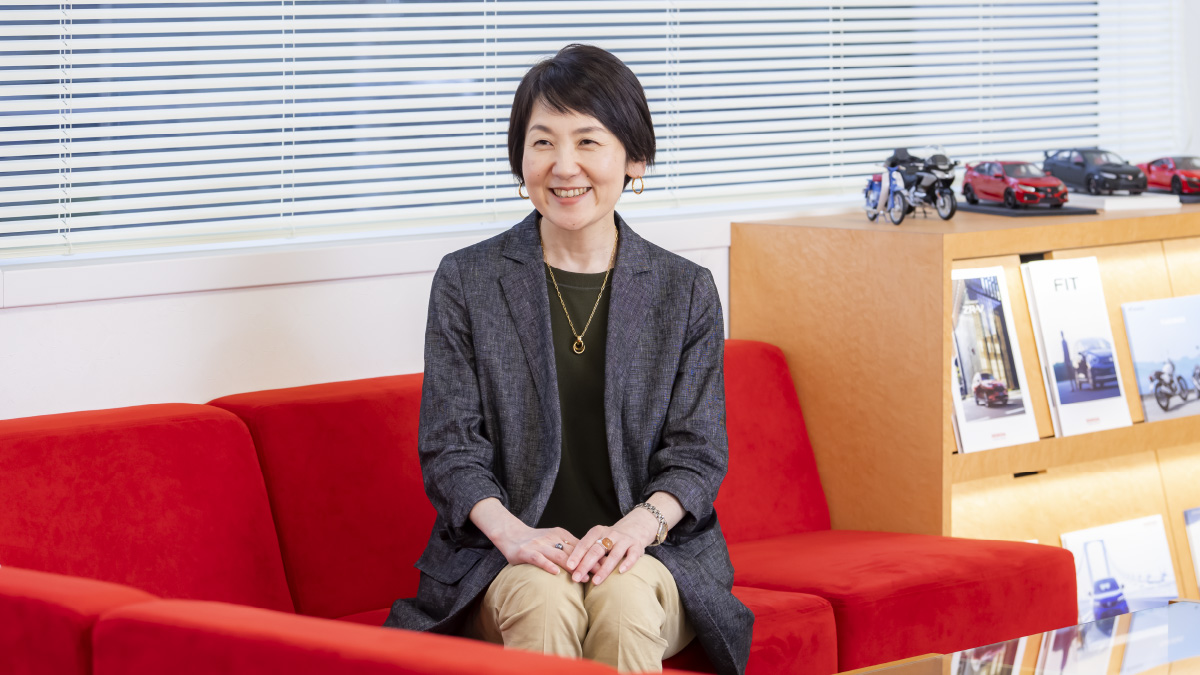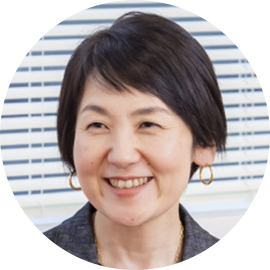Innovation
(Original issue date: October 9, 2023)
Mission and Dream of a Public Relations Representative: Keep Communicating Honda Philosophy

Index
Matsuyama has diverse experience in a number of different fields such as domestic and overseas marketing, product planning, and sales planning. Her present responsibilities include public relations and corporate branding strategy to deliver Honda’s corporate culture and philosophy, which she admires so much as to have joined the company. This article features an interview with Matsuyama, who has demonstrated such leadership in a variety of areas that a biased view of “not for women” is dismissed, covering her memorable experience in product planning, values as a leader, and women’s way of working.

Head
Corporate Communications Supervisory Unit
Corporate Communications Unit
Yasuko Matsuyama
Engaged extensively in market research and marketing, product planning, overseas sales, public relations, etc.
Doing the best in a given environment
- What are your responsibilities in the Corporate Communications Unit to which you belong now?
MatsuyamaI communicate Honda’s visions and appeal through activities of public relations, corporate promotion, inner branding, etc. The recent project I was involved in is called the “Honda Heart”, which is designed to communicate within and outside the company Honda’s various efforts and what lies behind them, such as thoughts and philosophy. This project was widely accepted even by the younger generation.
- What is your background working for Honda?
MatsuyamaAfter joining Honda, I was assigned to domestic sales for about 11 years. Even though the job function was described as sales, my tasks involved mainly marketing-related operations such as data-based quantitative market research, group interviews, and door-to-door surveys.
Then, when I was around 30 years old, I was appointed as a project leader of the product planning in the sales department for the compact car “LIFE”, which had kicked off in 2001.
Product planning is traditionally led by leaders from each division of Sales, R&D, and Production. Given the differences in gender awareness at that time and the limited number of female associates, when I joined the team, no woman had ever been selected as a leader. Under such an environment, it was the “LIFE” project that I was given a chance to lead.

- Which operations were you in charge of after that?
MatsuyamaAfter spending approximately three years on the “LIFE” project, I dedicated the following two years to working on the early stages of the Chinese business. Then, I was assigned to the domestic aftermarket business. I had been dealing with new models up until that time, but from this point on, the after-sales service came into the scope of my job.
At that time, the care after new model sales fell far short. We focused on what was missing and commoditized the “maintenance package” which covered necessities for car inspection and regular maintenance. Under conditions of neither budget allocation nor enough manpower, a one-page tool that we call “Pera-kata”* was all we had for sales promotion. But by carefully studying the two points: whether the package met with customers’ needs, and whether dealers could sell it with confidence, the maintenance package took root in the market. This is one of the projects that I can proudly say that I did a good job in.
Once exiting from the aftermarket business and subsequently being involved in overseas sales, I was transferred to the department I currently belong to about five or six years ago. There, I am currently engaged in branding and public relations.
*Simple catalog
Once the objective is defined, people will act without any instruction
- Was the aforementioned product planning of the “LIFE” memorable to you?
MatsuyamaYes. It was an unforgettable job, especially because I was at last appointed as a leader for it. The “LIFE” was primarily targeted at female customers. In response to the psychology of women who place priority on colors when choosing a car, I suggested miniatures in actual vehicle colors as promotional tools.
As the downside of this colored miniatures were very expensive for a promotional tool, so some people within the company were concerned that it would be too much to ask dealers to pay for them. I explained that they would be absolutely necessary for customers who were considering buying a car, and we managed to bring the idea to fruition. In the end, the tool was such a success that it was said that customers would most likely purchase a car when they started choosing a color from the colored miniatures on the negotiation table. I felt a great sense of joy when dealers provided positive feedback, acknowledging the miniatures as the best promotional tool of the decade.

- What is your impression on women’s way of working at Honda now and back when you joined the company?
MatsuyamaBecause laws and way of working in the 90s were particularly different from now, there were few cases of women being appointed as a leader. Around or after 2000, we started to see more women being hired. When the gender proportion gap is narrower, we tend to demonstrate our capabilities and voice our opinions in a more balanced manner. For solving issues, I think it would be easier to find new clues or different approaches when we take in female insights rather than doing men-only discussions. For that, it is crucial to create an environment where hired women can continue working without leaving.
- What is important for you based on your experience of overcoming these difficulties to have become a leader?
MatsuyamaI value an objective for what and for whom I work. In a Honda term, it is called “A00”. When the objective is clear, project members and successors are convinced by the direction it goes. Moreover, they can recognize by themselves what they have to do to carry on. Thus, I am particularly meticulous about articulating purposes.

To have diverse perspectives and be a company that society wants to exist
- What is your dream to realize at Honda in the future?
MatsuyamaI joined Honda not because I had a dream or a goal to achieve here, but because I have empathy for Honda’s corporate culture and philosophy handed down from Soichiro Honda, the founder. Rather than making my dream come true, I have been driven to continue working by the aspiration to contribute to customers and the company through finding and overcoming challenges in a given environment.
Because I am currently in charge of public relations, and it is my division’s mission to increase Honda’s fan base through communicating Honda’s corporate culture and philosophy. As one of Honda’s fans, it is also what I want to do.
Since I am not yet fully satisfied with our public relations activities, my dream is to expand the scope so that people within and outside the company appreciate how nice Honda is.
- Lastly, please give a message to working women.
MatsuyamaI believe that sharing our viewpoints and opinions regardless of gender can bring new ideas required by the society. For that sake, I hope women will speak up when they feel something is not quite right. I did not appreciate being asked to employ my femininity; however, I recognize that perspectives differ between genders after all. I believe what is discovered in this sort of differences is needed not only at Honda but also in the entire society. I would like to see these discoveries be uncovered and leveraged.
Not only men but for all of those who have their sights set on joining the management, I strongly recommend going for the challenge. You will face pressure, but you have to climb up the ladder to see the different view from the top. Furthermore, you can gain different experience from what you had before the challenge. I would push them forward if they want to go for it.

- Honda Stories
- Innovation
- Mission and Dream of a Public Relations Representative: Keep Communicating Honda Philosophy
